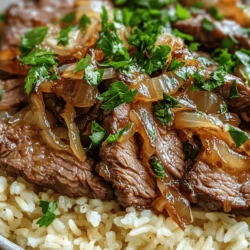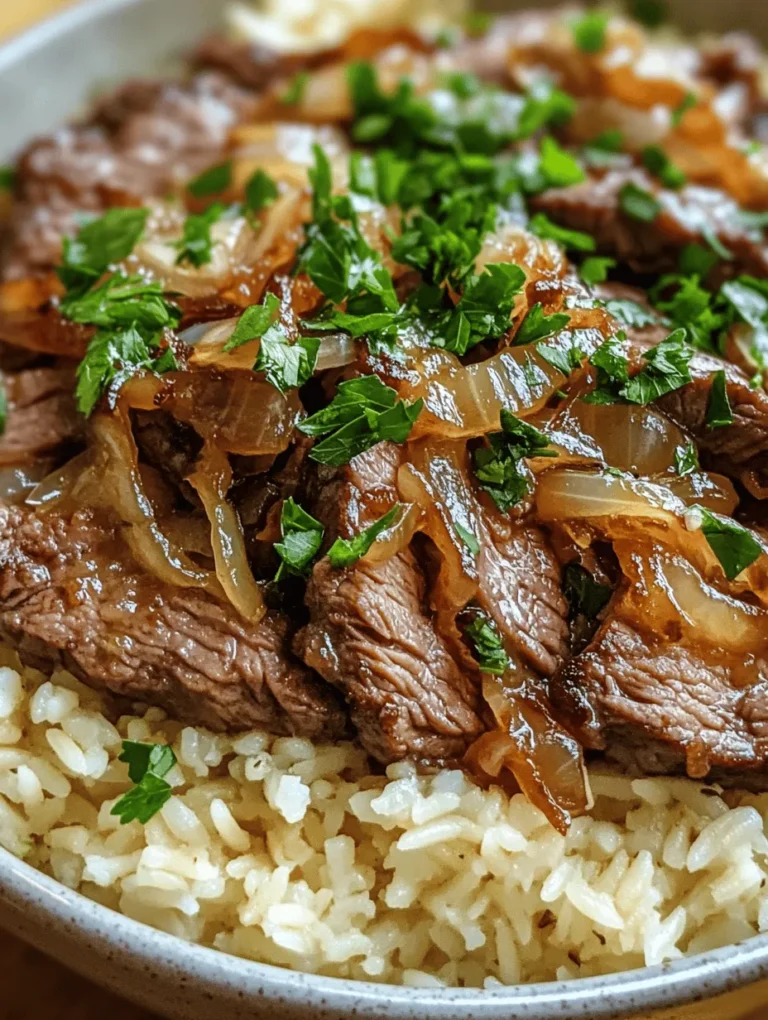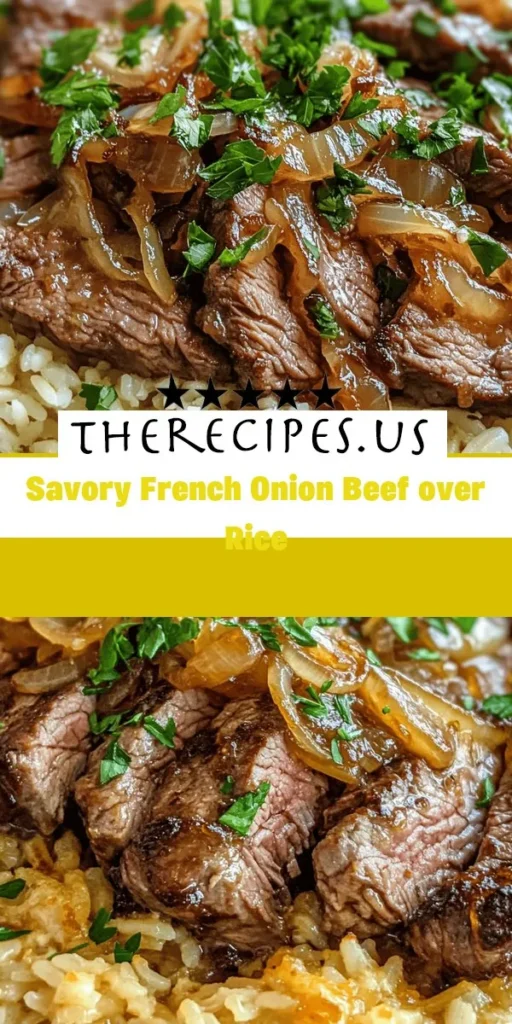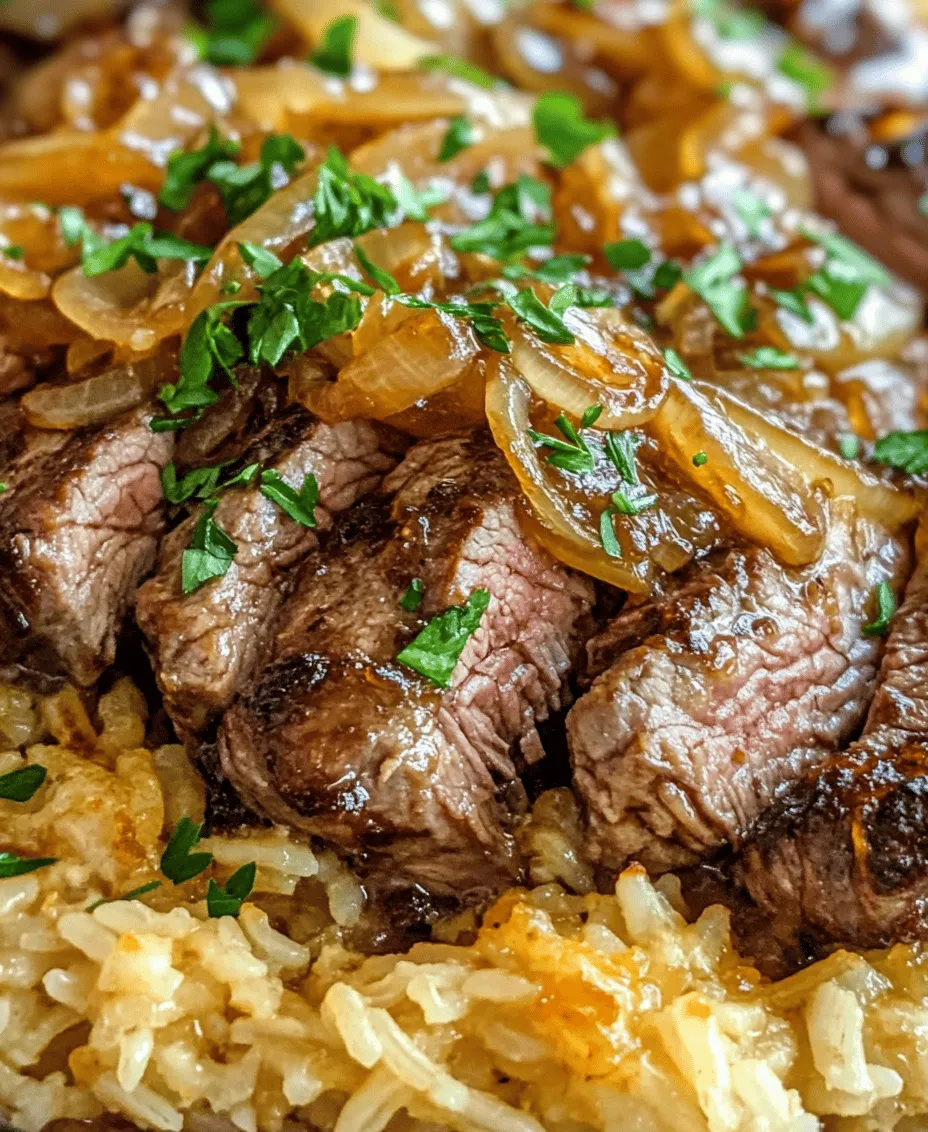Introduction
In the realm of comfort food, few dishes can rival the rich, hearty satisfaction of a well-prepared beef dish. Among these, Savory French Onion Beef Over Rice stands out as a perfect blend of flavors, textures, and aromas that can transform any ordinary meal into a delightful culinary experience. This dish marries the classic taste of French onion soup with tender beef, all served over a fluffy bed of rice, making it an ideal choice for a cozy family dinner or a comforting meal after a long day.
Comfort food plays a significant role in our daily lives. It brings warmth and nostalgia, evoking memories of home-cooked meals shared with loved ones. In our fast-paced world, having a go-to recipe that satisfies both the palate and the soul is essential. Savory French Onion Beef Over Rice is not only satisfying but also incredibly versatile, allowing for variations that can cater to personal tastes or dietary preferences. The combination of savory beef, sweet caramelized onions, and perfectly cooked rice creates a symphony of flavors that is hard to resist.
As we delve into this recipe, you’ll discover how each ingredient contributes to the final dish and how you can master the cooking process to achieve a restaurant-quality meal right in your kitchen.
Understanding the Ingredients
The heart of any great dish lies in its ingredients. For Savory French Onion Beef Over Rice, each component plays a crucial role in building layers of flavor that harmonize beautifully. Let’s break down the key ingredients that make this dish a standout.
Beef Sirloin: Choosing the Right Cut for Tenderness
When it comes to the star of the dish, beef sirloin is an excellent choice. This cut is known for its balance of flavor and tenderness, making it perfect for sautéing and simmering. When selecting beef, look for cuts that have a good amount of marbling—this intramuscular fat not only enhances the flavor but also ensures that the meat remains juicy during cooking.
You can choose between top sirloin or bottom sirloin, with the former being slightly more tender. When preparing the beef, it’s essential to cut it into uniform pieces to ensure even cooking.
Yellow Onions: The Foundation of Flavor Through Caramelization
Next up are yellow onions, the backbone of this dish’s flavor profile. Onions provide a natural sweetness that transforms through the process of caramelization. This technique involves slowly cooking the onions until they turn a deep golden brown, allowing their natural sugars to develop and intensify. The longer you take to caramelize them, the richer and more complex the flavor becomes.
When selecting onions, choose firm ones with smooth, dry skins. Avoid any with soft spots or blemishes, as these can affect the overall quality of your dish.
Garlic: Enhancing the Dish with Aromatic Richness
Garlic is another essential ingredient that enhances the dish with aromatic richness. A few cloves, minced or finely chopped, introduce a robust flavor that complements the sweetness of the onions and the hearty nature of the beef. Adding garlic at the right time during cooking is crucial; if added too early, it can burn and turn bitter, overshadowing the other flavors.
Beef Broth: Adding Depth and Umami
To create a luscious sauce that envelops the beef and rice, beef broth is indispensable. It adds depth and umami, enriching the overall flavor of the dish. For the best results, opt for low-sodium beef broth, allowing you to control the saltiness of the final dish. If you prefer homemade broth, it can also be a great way to infuse additional flavors.
Rice: The Perfect Base to Soak Up Flavors
Rice serves as the perfect base for this dish, soaking up the savory sauce and providing a neutral backdrop to the bold flavors. Long-grain varieties, such as basmati or jasmine, work particularly well, as they remain fluffy and separate when cooked. You can also use brown rice for a nuttier flavor and added nutritional benefits. Cooking the rice according to package instructions ensures that it complements the beef and sauce beautifully.
Herbs and Seasonings: Thyme and Worcestershire Sauce for Complexity
To elevate the dish further, herbs and seasonings like thyme and Worcestershire sauce are added. Thyme brings an earthy aroma and pairs beautifully with the beef, while Worcestershire sauce contributes a tangy depth that enhances the overall flavor profile. A touch of black pepper can also be used to season the beef, providing a subtle kick without overpowering the dish.
Cheese: The Crowning Glory That Adds Creaminess
Finally, no French onion-inspired dish is complete without cheese. A sprinkle of grated Gruyère or Swiss cheese over the top of the beef before serving adds a creamy, melty layer that ties everything together. The cheese not only adds richness but also brings a familiar comfort element to the dish, reminiscent of the classic French onion soup.
Step-by-Step Cooking Process
Now that we have a solid understanding of the ingredients, let’s move on to the step-by-step cooking process to create this delicious Savory French Onion Beef Over Rice.
Sautéing the Onions
The first step in this recipe is to sauté the onions, which is crucial for developing the dish’s flavor. Begin by slicing the yellow onions thinly; this will help them cook evenly and caramelize beautifully.
Importance of Caramelization for Flavor Development
Caramelization occurs when the natural sugars in the onions break down and turn golden brown. This process intensifies their sweetness and adds a complex flavor that is essential to the dish. To achieve perfect caramelized onions, it’s important to cook them low and slow. Start by heating a tablespoon of oil (olive oil or vegetable oil) in a large skillet over medium heat. Once the oil is hot, add the sliced onions and a pinch of salt to help draw out moisture.
Tips for Achieving the Perfect Golden Color
– Patience is key. Allow the onions to cook for about 20-30 minutes, stirring occasionally. If they start to stick or burn, lower the heat slightly.
– If you want to boost the caramelization process, consider adding a teaspoon of sugar to the onions after about 10 minutes of cooking. This will enhance their sweetness and help achieve that desirable golden color.
– Once the onions are caramelized to your liking, remove them from the skillet and set them aside.
Cooking the Beef
With the onions perfectly caramelized, it’s time to cook the beef. In the same skillet, add a little more oil if necessary and increase the heat to high.
Importance of High Heat for Browning
High heat is crucial for achieving a good sear on the beef, which enhances flavor through the Maillard reaction. This process creates a complex crust on the meat that adds depth to the dish.
How to Season for Optimal Flavor
Before adding the beef to the skillet, season it generously with salt and black pepper. This basic seasoning helps to enhance the natural flavors of the meat. Once the skillet is hot, add the beef sirloin pieces in batches, ensuring not to overcrowd the pan. Allow the beef to sear without moving it for a couple of minutes to achieve a nice browning.
Once browned, turn the beef to cook all sides, then remove it from the skillet and set it aside with the caramelized onions.
Creating the Broth Mixture
The next step involves creating the broth mixture that will bring all the flavors together. In the same skillet, reduce the heat to medium and add minced garlic to the remaining juices left from the beef.
Deglazing and Its Role in Flavor Enhancement
Deglazing is the process of adding liquid to the skillet to loosen the browned bits (fond) stuck to the bottom. This adds a tremendous depth of flavor to the broth. Pour in a splash of beef broth and scrape the bottom of the skillet with a wooden spoon to release the fond.
Once the bits are loosened, add the remaining beef broth, Worcestershire sauce, and thyme. Bring the mixture to a simmer, allowing the flavors to meld together.
Simmering for Tenderness and Infusion of Flavors
After the broth is simmering, return the cooked beef and caramelized onions to the skillet. Ensure the beef is well-coated in the broth, then cover the skillet and let it simmer on low heat for about 20-30 minutes. This allows the beef to absorb the flavors and become tender while the broth reduces into a rich sauce.
As the dish cooks, prepare your rice according to package instructions, ensuring it will be ready to serve alongside the savory beef and sauce.
—
By following these steps, you will create a dish that not only satisfies hunger but also provides a comforting warmth that is perfect for any occasion. In the next part, we will explore tips for achieving the best results and answer some common questions about this delightful recipe.



